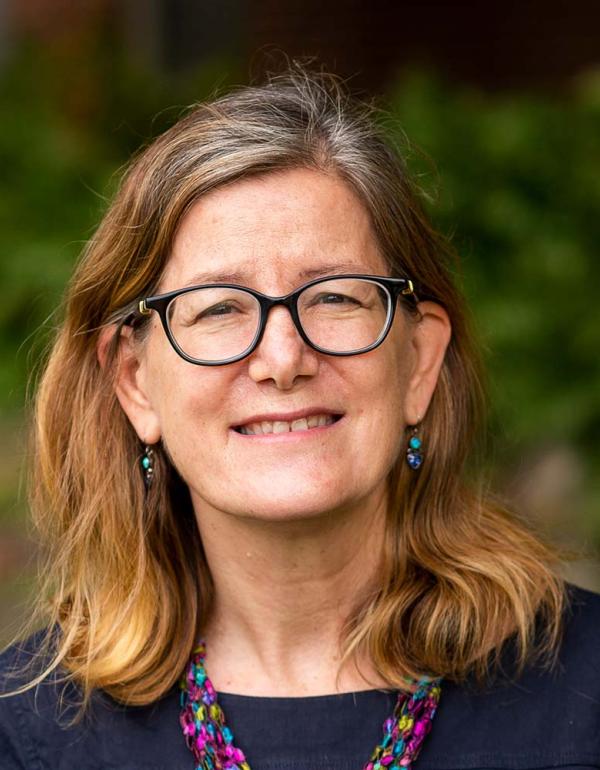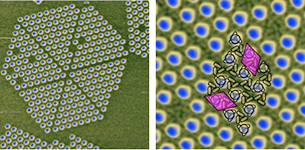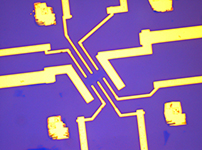

Education
- B.S., Chemistry, 1980, Haverford College, Haverford, PA
- Ph.D., Physical Chemistry, 1986, University of California, Berkeley (w. Yuan T. Lee and David A. Shirley)
- Postdoctoral, 1988, A. T. & T. Bell Laboratories, Murray Hill, NJ (w. Yves. Chabal)
Professional Experience
- Chair, Department of Chemistry & Biochemistry, University of Maryland, 2013 – 2025
- Professor, Department of Chemistry & Biochemistry, University of Maryland, 2003 – present
- Director, Materials Research Science & Engineering Center, University of Maryland, 2010-present
- Assoc. Chair for Graduate Studies, Dept. of Chemistry & Biochemistry, University of Maryland, 2004-06
- Associate Professor, Dept. of Chemistry & Biochemistry, University of Maryland, 1994 – 2003
- Assistant Professor, Dept. of Chemistry & Biochemistry, University of Maryland, 1988 – 1994
Research Interests
Surface Chemistry and Nanoscale Science, Supramolecular Chemistry, Energy Storage & Production in Nanostructured Materials, Directed Assembly and Molecular Engineering, Organic Semiconductors, Supported Nanostructures, Mass Transport Processes & Interface Evolution; Scanning Probe Methods, Surface Spectroscopies.
Professional Societies
American Chemical Society (ACS), AVS – The Science & Technology Society, American Physical Society
(APS)
Major Recognitions and Honors
- Rowan Award (2012)
- Alfred P. Sloan Fellow (1994-1996)
- Packard Fellow (1990-1995)
- NSF Presidential Young Investigator 1990 – 1995)
- Dupont Graduate Fellow (1983)
- Dupont Summer Research Fellow (1980)
- Lyman Beecher Hall Award (1980)
- American Institute of Chemists Award (1980)
Significant Professional Service and Activities
Physical Electronics Conference: Executive Committee 1994 – 2004, vice-General Chair 1997 – 2000
General Chair 2000 – 2004; AVS – Science & Technology Society: Science & Technology Policy Committee 2004 – present, Surface Science Division Executive Committee 2009-2013, Program Chair 2012, Division Chair 2013, American Chemical Society: Symposium Organizer (2000), American Institute for Physics: Science & Technology Policy Committee 2004 – present, American Physical Society: Symposium Organizer 2012, 2009, 1990; Materials Research Science & Engineering Center: Co-founder 1990, Executive Committee Member 1990 – present, Maryland GAANN Chemistry Scholar – Educators, Director 2006 – 2012
Students Mentored
Since 1995, 10 students have received PhD’s in Chemistry (5), Chemical Physics (3), and Physics (1); 2 students have received M.S.’s in Analytical Chemistry; 10 undergraduate students have obtained research experience, with 7 proceeding to graduate school in chemistry (5), material science (1) and pharmaceutical science(1) and 2 proceeding to medical school Twelve post-doctoral Fellows have been trained by Reutt-Robey, and proceeded to faculty positions (4), research positions in national (4) or international (1) laboratories, and industrial positions (3).
Surface Chemistry & Nanoscience
Our research centers on the formation of chemical interfaces and nanostructures with targeted electronic and chemical properties for application in energy production and storage and nanotechnology. Fundamentally, we are interested in configuring atomic and molecular arrangements in films and supported nanostructures to impact dynamical processes – such as diffusion, charge-transfer and chemical binding. New electronic device concepts, based upon low-dimensional material interfaces, are investigated. Our main experimental tools are ultrahigh vacuum (UHV) scanned probe microscopies and surface spectroscopies, developed in combination with novel deposition methods. Current projects are outlined below.
Directed Assembly
 Molecular semiconductors with desirable optical and electronic properties are useful building blocks for energy and nanoelectronic devices. We direct the assembly of molecular components, such as Fullerenes, Metal Phthalocyanines and Pentacenes, using kinetically-controlled interactions into nanopatterned arrangements. We employ Scanning Tunneling Microscopy (STM) and noncontact Atomic Force Microscopy (nc-AFM) to develop structure motifs, such as molecular chains, chiral pinwheels, and molecular checkerboards, and characterize emergent properties. (NSF-CHE Support)
Molecular semiconductors with desirable optical and electronic properties are useful building blocks for energy and nanoelectronic devices. We direct the assembly of molecular components, such as Fullerenes, Metal Phthalocyanines and Pentacenes, using kinetically-controlled interactions into nanopatterned arrangements. We employ Scanning Tunneling Microscopy (STM) and noncontact Atomic Force Microscopy (nc-AFM) to develop structure motifs, such as molecular chains, chiral pinwheels, and molecular checkerboards, and characterize emergent properties. (NSF-CHE Support)
Polymorph Selection
 Organic molecules yield multiple crystalline forms, known as polymorphs, with distinctive physico-chemical properties. Polymorph control is particularly important in pharmaceuticals to achieve solubility targets for drug delivery, and is required patent information in new drugs. We investigate crystal-formation processes in functionalized organic molecules under nonequilibrium growth conditions. Substrate templates and heterochemical seeds are used to control nucleation and growth. The structure and electrostatic contours of nanocrystallite surfaces are investigated with molecularly-resolved topographic and potentiometric imaging.
Organic molecules yield multiple crystalline forms, known as polymorphs, with distinctive physico-chemical properties. Polymorph control is particularly important in pharmaceuticals to achieve solubility targets for drug delivery, and is required patent information in new drugs. We investigate crystal-formation processes in functionalized organic molecules under nonequilibrium growth conditions. Substrate templates and heterochemical seeds are used to control nucleation and growth. The structure and electrostatic contours of nanocrystallite surfaces are investigated with molecularly-resolved topographic and potentiometric imaging.
Symmetry-Breaking Adsorbates in Graphene
 Graphene has unique optical and electronic properties that form the basis for nanotechnology applications. However, the lack of an electronic band gap in this atomically thin material is a major limitation for electronic switching. We are exploring the use of chemical adsorbates as a means to open a gap through selective occupation of A/B sublattice sites. We prepare 2-D molecular films on graphene to screen for symmetry-breaking configurations and test for electronic functioning in graphene devices. (NSF-MRSEC Support)
Graphene has unique optical and electronic properties that form the basis for nanotechnology applications. However, the lack of an electronic band gap in this atomically thin material is a major limitation for electronic switching. We are exploring the use of chemical adsorbates as a means to open a gap through selective occupation of A/B sublattice sites. We prepare 2-D molecular films on graphene to screen for symmetry-breaking configurations and test for electronic functioning in graphene devices. (NSF-MRSEC Support)
Energy-Storing Nanostructures
 Energy storage is essential in portable energy systems and for the effective utilization of renewable energy sources. Nanostructured materials have a greater capacity for electrical energy storage and rapid delivery than current materials, with potential to address future energy needs. Basic research is needed to develop charge-storage concepts in discrete nanostructures. We fabricate models of nanobattery materials, such as beta-MnO2 nanocrystals (cathode) supported on HOPG (anode), to investigate Li+ insertion/de-insertion processes associated with charging/discharging. Probe tips function as Li+ nanopipettes and address nanocrystal facets, probing insertion selectivity. A related project involves the study of electrolyte structure and decomposition at model cathode surfaces, under charging/discharging. Molecular mechanisms leading to the formation of a solid electrolyte interface are explored quantitatively. (DOE-EFRC Support: UMD NEES)
Energy storage is essential in portable energy systems and for the effective utilization of renewable energy sources. Nanostructured materials have a greater capacity for electrical energy storage and rapid delivery than current materials, with potential to address future energy needs. Basic research is needed to develop charge-storage concepts in discrete nanostructures. We fabricate models of nanobattery materials, such as beta-MnO2 nanocrystals (cathode) supported on HOPG (anode), to investigate Li+ insertion/de-insertion processes associated with charging/discharging. Probe tips function as Li+ nanopipettes and address nanocrystal facets, probing insertion selectivity. A related project involves the study of electrolyte structure and decomposition at model cathode surfaces, under charging/discharging. Molecular mechanisms leading to the formation of a solid electrolyte interface are explored quantitatively. (DOE-EFRC Support: UMD NEES)
Nanophotovoltaics
 Organic photovoltaics offer the opportunity for more widespread utilization of solar energy. A key strategy for device improvement is to optimize the orientation of the donor-acceptor interfaces, and set domain sizes below the exciton diffusion length in the active film. We investigate nanostructuring in binary semiconducting films, generating donor-acceptor interfaces with prescribed molecular orientation. Charge-separation dynamics at oriented interfaces is measured with a 2-photon photoelectron spectroscopy, in collaboration with researchers at the National Institute of Standards & Technology. (NSF-CHE, NSF-MRSEC, NIST Support)
Organic photovoltaics offer the opportunity for more widespread utilization of solar energy. A key strategy for device improvement is to optimize the orientation of the donor-acceptor interfaces, and set domain sizes below the exciton diffusion length in the active film. We investigate nanostructuring in binary semiconducting films, generating donor-acceptor interfaces with prescribed molecular orientation. Charge-separation dynamics at oriented interfaces is measured with a 2-photon photoelectron spectroscopy, in collaboration with researchers at the National Institute of Standards & Technology. (NSF-CHE, NSF-MRSEC, NIST Support)
Representative Publications
- Burson, K. M et al., Potential Steps at C60-TiOPc-Ag(111) Interfaces: UHV-Noncontact Scanning Probe Metrology, Nano Lett., 2012, 12, 2859:64; DOI: 10.1021/nl3004607
- Tskipuri, L. et al., Solvent-assisted growth of metal phthalocyanine thin films on Au(111). J. Vac. Sci. Technol., A, 2012. 30: p. 031402/1-031402/4.
- Wei, Yinying, Reutt-Robey,. J. E., Directed organization of C70 kagome lattice by titanyl phthalocyanine monolayer template, J. Am. Chem. Soc., 2011 133(39):15232-5.
- Calzolari, A. et al., Substrate-Mediated Intermolecular Hybridization in Binary Phthalocyanine Superstructures. J. Phys. Chem. C, 2010. 114: p. 1041-1045.
- Dougherty, D.B. et al., Local transport gap in C60 nanochains on a pentacene template. Phys. Rev. B: Condens. Matter Mater. Phys., 2008. 77: p. 073414/1-073414/4.
- Dougherty, D.B. et al., Variable Temperature Scanning Tunneling Microscopy of Pentacene Monolayer and Bilayer Phases on Ag(111). J. Phys. Chem. C, 2008. 112: p. 20334-20339.
- Dutton, G.J. et al., Ultrafast charge-transfer processes at an oriented phthalocyanine/C60 interface. Phys. Rev. B:., 2010. 82 2011: p. 073407/1-073407/4.
- Jin, W. et al. C60-Pentacene Network Formation by 2-D Co-Crystallization. Langmuir, 2009. 25: p. 9857-9862.
- Tao, C. et al. Dynamic interfaces in an organic thin film. Proc. Natl. Acad. Sci. U. S. A., 2008: p. 1-8, 8 pp.
- Thuermer, K. et al., Autocatalytic oxidation of lead crystallite surfaces. Science , 2002. 297: p. 2033-2035.


